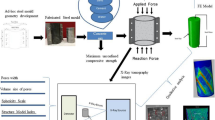Abstract
Comprehensive microstructural investigations were performed on normal-strength (33 MPa) and relatively high-strength concrete (43 MPa) as well as concrete specimens with and without restraint against drying shrinkage movement. The effects of different load and environmental damaging phenomena (cold and hot environment) on concrete microcrack system were detected. Fluorescent and environmental scanning electron microscopy (ESEM) techniques with image analysis methodologies were employed to quantify microcrack attributes on planar sections. Stereological aspects were used to derive information on spatial (3-D) microcrack systems in terms of planar (2-D) quantitative data generated on perpendicular sections. Statistical analysis of data was used to determine the differences in microcrack characteristics between normal-strength versus relatively high-strength and unrestrained versus restrained specimens.
Résumé
Des investigations complètes ont été exécutées au plan microstructurel sur du béton ordinaire (33 MPa) et sur du béton à performances relativement hautes (43 MPa), ainsi que sur des éprouvettes avec et sans contraintes agissant sur le mouvement de retrait au séchage. Les effets de différents phénomènes d'endommagement sous chargement ou environnemental (environnement froid et chaud) sur le système de microfissuration du béton ont été détectés. Des techniques de microscopie électronique à balayage fluorescent et environnemental (ESEM) ont été employées avec les méthodologies d'analyse d'images pour quantifier les attributs des microfissures sur les sections planaires. Les aspects stéréologiques ont été utilisés pour obtenir des informations sur les systèmes de microfissuration spatiale (3-D) en termes de données quantitatives planaires (2-D) générées sur des sections perpendiculaires. L'analyse statistique de ces données a été utilisée pour déterminer les différences de caractéristiques des microfissures entre béton ordinaire et béton à performances relativement hautes, et éprouvettes avec et sans contraintes.
Similar content being viewed by others
Abbreviations
- AAC1 :
-
Crack area fraction on the first (horizontal-perpendicular to the direction of loading) section
- AAC2 :
-
Crack area fraction on the second (vertical-parallel to the direction of loading) section
- AiC :
-
Area of each individual crack
- Aicm :
-
Mean of the area of each individual crack in the section of interest
- LAC1 :
-
Crack length per unit area of the first (horizontal-perpendicular to the direction of loading) section
- LAC2 :
-
Crack length per unit area of the second (vertical-parallel to the direction of loading) section
- LiC :
-
Length of each individual crack
- WCP1 :
-
Crack width in plane in the first (horizontal-perpendicular to the direction of loading) section
- WCP2 :
-
Crack width in plane in the second (vertical-parallel to the direction of loading) section
- WiC :
-
Width of each individual crack
References
Lin, W., Lin, T. and Couche-Powers, L., ‘Microstructure of Fire-Damaged Concrete’,ACI Materials Journal 93 (USA, 1996) 199–205.
Hall, C. and Bosbach, D., ‘Scanning probe microscopy: a new view of the mineral surface’, in ‘Material Science of Concrete VI’, edited by Mindess, S. and Skalny, J. (The American Ceramic Society, 2001) 101–128.
Sakata, Y. and Ohtsu, M., ‘Crack evaluation in concrete members based on ultrasonic spectroscopy’,ACI Materials Journal 92 (USA, 1995) 686–698.
Ping, G., Zhongzi, X., Ping, X. and Beaudoin, J., ‘An A.C. impedance spectroscopy study of micro-cracking in cement-based composites during compressive loading’,Cement and Concrete Research 23 (USA, 1993) 675–682.
Berliner, R., ‘Neutron diffraction and neutron scattering’, in ‘Material Science of Concrete VI’, edited by Mindess, S. and Skalny, J. (The American Ceramic Society, 2001) 49–99.
Roode-Gutzmer, Q. and Ballim, Y., ‘Phase composition and quantitative X-ray powder diffraction analysis of Portland cement and clinker’, in ‘Material Science of Concrete VI’, edited by Mindess, S. and Skalny, J. (The American Ceramic Society, 2001) 1–48.
Young, J., ‘The microstructure of hardened Portland cement paste’, in ‘Creep and Shrinkage in Concrete Structures’, edited by Bažant, Z.P. and Wittmann, F.H. (John Wiley & Sons Ltd, 1982) 3–22.
Scrivener, K., ‘The microstructure of concrete’, in ‘Material Science of Concrete I’, edited by Skalny, J. (The American Ceramic Society, 1989) 127–161.
Shayan, A. and Quick, G., ‘Microscopic features of cracked and uncracked concrete railway sleepers’,ACI Materials Journal 89 (USA, 1992) 348–361.
Beaudoin, Y., ‘Microcracking as a precursor to delayed ettringite formation in cement systems’,Cement and Concrete Research 26 (USA, 1996) 1493–1498.
Tay, D. and Tam, C., ‘In situ investigation of the strength of deteriorated concrete’,Construction and Building Materials 10 (London, 1996) 17–26.
Thomas, S. and Albert, B., ‘Alkali-silica reaction in marine piles,’Concrete International 19 (USA, 1997) 59–62.
Ringot, E., ‘Automatic quantification of microcracks network by stereological method of total projection in mortars and concretes’,Cement and Concrete Research 18 (USA, 1988) 35–43.
Smadi, M. and Slate, F., ‘Microcracking of high and normal strength concrete under short-and long-term loadings’,ACI Materials Journal 86 (USA, 1989) 117–127.
Carrasquillo, R., Slate, F. and Nilson, A., ‘Microcracking and behavior of high strength concrete subject to short-term loading’,ACI Materials Journal 11 (USA, 1981) 179–186.
Ngab, A., State, F. and Nilson, A., ‘Microcracking and time-dependent strains in high strength concrete’,ACI Materials Journal 11 (USA, 1981) 262–268.
Emmanuel, K. and David, D., ‘Submicrocracking in cement paste and mortar’,ACI Materials Journal 84 (USA, 1987) 491–500.
Stang, H., Mobasher, B. and Shah, P., ‘Quantitative damage characterization in polypropylene fiber reinforced concrete’,Cement and Concrete Research 20 (USA, 1990) 540–558.
Mobasher, B., Stang, H. and Shah, S.P., ‘Microcracking in fiber reinforced concrete’,Cement and Concrete Research 20 (USA, 1990) 665–676.
Nemati, K., Monteiro, J. and Scrivener, K., ‘Analysis of compressive stress-induced cracks in concrete’,ACI Materials Journal 98 (USA, 1998) 617–630.
Underwood, E.E., ‘Quantitative Stereology’ (Addison-Wesley Publishing Company, 1970—New Jersey, 1968) 23, 48–105.
Weibel, R.W., ‘Stereological methods’: ‘Practical for biological morphometry’,Academic Press 2 (USA, 1979) 261–263 & 299–305.
Author information
Authors and Affiliations
Rights and permissions
About this article
Cite this article
Elzafraney, M., Soroushian, P. Assessment of microcrack development in concrete materials of different strengths. Mat. Struct. 37, 724–731 (2004). https://doi.org/10.1007/BF02480518
Received:
Accepted:
Issue Date:
DOI: https://doi.org/10.1007/BF02480518




